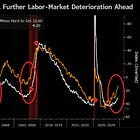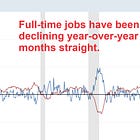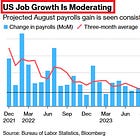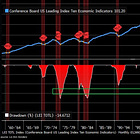US job numbers have been revised down by 818,000 for the 12 months through March 2024
Economic data revisions have been much higher than usual over the last 18 months
Economic data is being revised regularly. This is especially true for the payroll numbers as usually its first release is based on incomplete data. Moreover, the monthly non-farm payrolls is a survey conducted by the Bureau of Labor Statistics (BLS) as it is impossible to check every single person in the country whether they are employed. Explanation of the incompleteness of these surveys has been outlined in the below articles:
Also more updated US labor market data can be seen below:
As economic data are revised they become more accurate over time but to get the final revisions takes a lot of time. Monthly job numbers are revised twice after the initial release where the BLS utilizes data from roughly 670,000 establishments.
Subsequently, 7-8 months after each quarter, the Business Employment Dynamics (BED) data is released utilizing data from 9.1 million establishments from the private sector. It is not a regular revision but a different piece of data that provides a sense of when the final revisions could end up. The most recent BED data were reported for Q4 2023 in July.
In general, the BED showed the US economy LOST 192,000 jobs in Q3 2023 and added 344,000 jobs in Q4 2023. On the other hand, the US labor market added 663,000 and 577,000 new jobs in Q3 and Q4 2023 when using non-farm payrolls data. In other words, job numbers were likely overstated by a massive 1,088,000 in the 2nd half of 2024. The release of Q1 2024 data is scheduled for October 30, 2024, and will include annual data revisions.
Finally, there are preliminary revisions every year which cover 12 months of non-farm payrolls data through March. The so-called QCEW data is based on unemployment insurance tax records filed by more than 12 million establishments. These usually come in the second half of August. This revision does not impact unemployment rate as this metric is calculated using the household survey (explained in the linked article above) while payrolls are based on the establishment survey (670,000 establishments). Namely, this is what has been reported today (August 21, 2024). It is worth keeping in mind, however, that this eventually will also be revised but we will know this early next year.
Full analysis of the aforementioned indicators as well as retail sales and industrial production revisions is presented in the following sections.
THAT WAS THE BIGGEST JOB DATA REVISION SINCE THE GLOBAL FINANCIAL CRISIS







